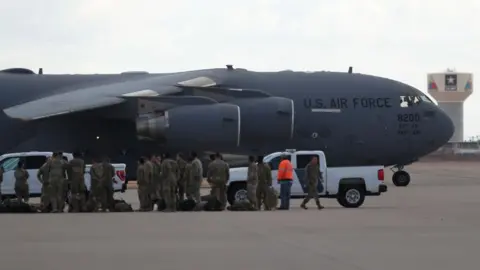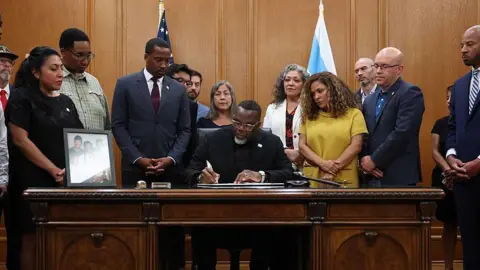The Texas floods that claimed lives have led to intense scrutiny of the National Weather Service (NWS) and its capabilities. Some Democrats point to workforce reductions initiated during the Trump administration as a potential factor in the tragedy, asserting that these cuts hindered the NWS's ability to predict the severity of the disaster accurately. Senator Chris Murphy highlighted the importance of accurate weather forecasting in preventing fatalities during such extreme weather events.
However, White House Press Secretary Karoline Leavitt defended the NWS's staffing levels, stating, "These offices were well staffed… so any claims to the contrary are completely false." Despite reports of staff reductions following Trump's administration's efficiency drive, meteorologists and climate experts have weighed in, indicating that the staffing in place during the Texas flooding was sufficient to manage the crisis effectively.
While the Trump administration proposed a 25% cut to NOAA's $6.1 billion budget for the 2026 fiscal year, these reductions were not enacted in time to have influenced the recent floods. Nevertheless, the NWS has undergone staffing changes resulting in approximately 600 job losses, leading to some offices operating under increased vacancy rates. Reports from April 2025 indicated a vacancy rate in half of NWS offices at about 20%, double that of the previous decade.
Despite these concerns, experts maintained that the NWS provided effective forecasts and warnings for the floods. Avantika Gori, from Rice University, noted that forecasting extreme rainfall events is inherently challenging. Another climate scientist, Andy Hazelton, confirmed that the watches and warnings were timely and adequately issued despite the staffing issues.
However, some analysts expressed concerns over coordinational efficacy, suggesting that local NWS offices may have been under-resourced, affecting cooperation with emergency services. The San Antonio and San Angelo offices, dealing directly with the flood-affected areas, had reported vacancies including crucial meteorological positions.
NWS staff efforts to bolster forecasting capacity during the crisis were noted, with both offices reportedly increasing forecasters on duty. Meteorologist Jason Runyen stated, “We had up to five on staff,” during the flooding, as opposed to two on a regular day.
Additionally, there have been concerns about reductions in weather balloon launches, a vital method for data collection. John Morales, a US meteorologist, pointed out a 20% overall reduction in weather balloon releases, which could impair forecasting capabilities. The NWS has confirmed that staffing shortages have led to suspensions in some launch operations, though there is no direct evidence linking this to the Texas floods, as launches at the closest station proceeded as planned.
As investigations continue, the debate remains on whether the federal cuts to NOAA and NWS staffing impacted the loss of life and property during the Texas floods, a tragedy prompting renewed discussions on disaster preparedness and federal funding for essential services.
However, White House Press Secretary Karoline Leavitt defended the NWS's staffing levels, stating, "These offices were well staffed… so any claims to the contrary are completely false." Despite reports of staff reductions following Trump's administration's efficiency drive, meteorologists and climate experts have weighed in, indicating that the staffing in place during the Texas flooding was sufficient to manage the crisis effectively.
While the Trump administration proposed a 25% cut to NOAA's $6.1 billion budget for the 2026 fiscal year, these reductions were not enacted in time to have influenced the recent floods. Nevertheless, the NWS has undergone staffing changes resulting in approximately 600 job losses, leading to some offices operating under increased vacancy rates. Reports from April 2025 indicated a vacancy rate in half of NWS offices at about 20%, double that of the previous decade.
Despite these concerns, experts maintained that the NWS provided effective forecasts and warnings for the floods. Avantika Gori, from Rice University, noted that forecasting extreme rainfall events is inherently challenging. Another climate scientist, Andy Hazelton, confirmed that the watches and warnings were timely and adequately issued despite the staffing issues.
However, some analysts expressed concerns over coordinational efficacy, suggesting that local NWS offices may have been under-resourced, affecting cooperation with emergency services. The San Antonio and San Angelo offices, dealing directly with the flood-affected areas, had reported vacancies including crucial meteorological positions.
NWS staff efforts to bolster forecasting capacity during the crisis were noted, with both offices reportedly increasing forecasters on duty. Meteorologist Jason Runyen stated, “We had up to five on staff,” during the flooding, as opposed to two on a regular day.
Additionally, there have been concerns about reductions in weather balloon launches, a vital method for data collection. John Morales, a US meteorologist, pointed out a 20% overall reduction in weather balloon releases, which could impair forecasting capabilities. The NWS has confirmed that staffing shortages have led to suspensions in some launch operations, though there is no direct evidence linking this to the Texas floods, as launches at the closest station proceeded as planned.
As investigations continue, the debate remains on whether the federal cuts to NOAA and NWS staffing impacted the loss of life and property during the Texas floods, a tragedy prompting renewed discussions on disaster preparedness and federal funding for essential services.




















